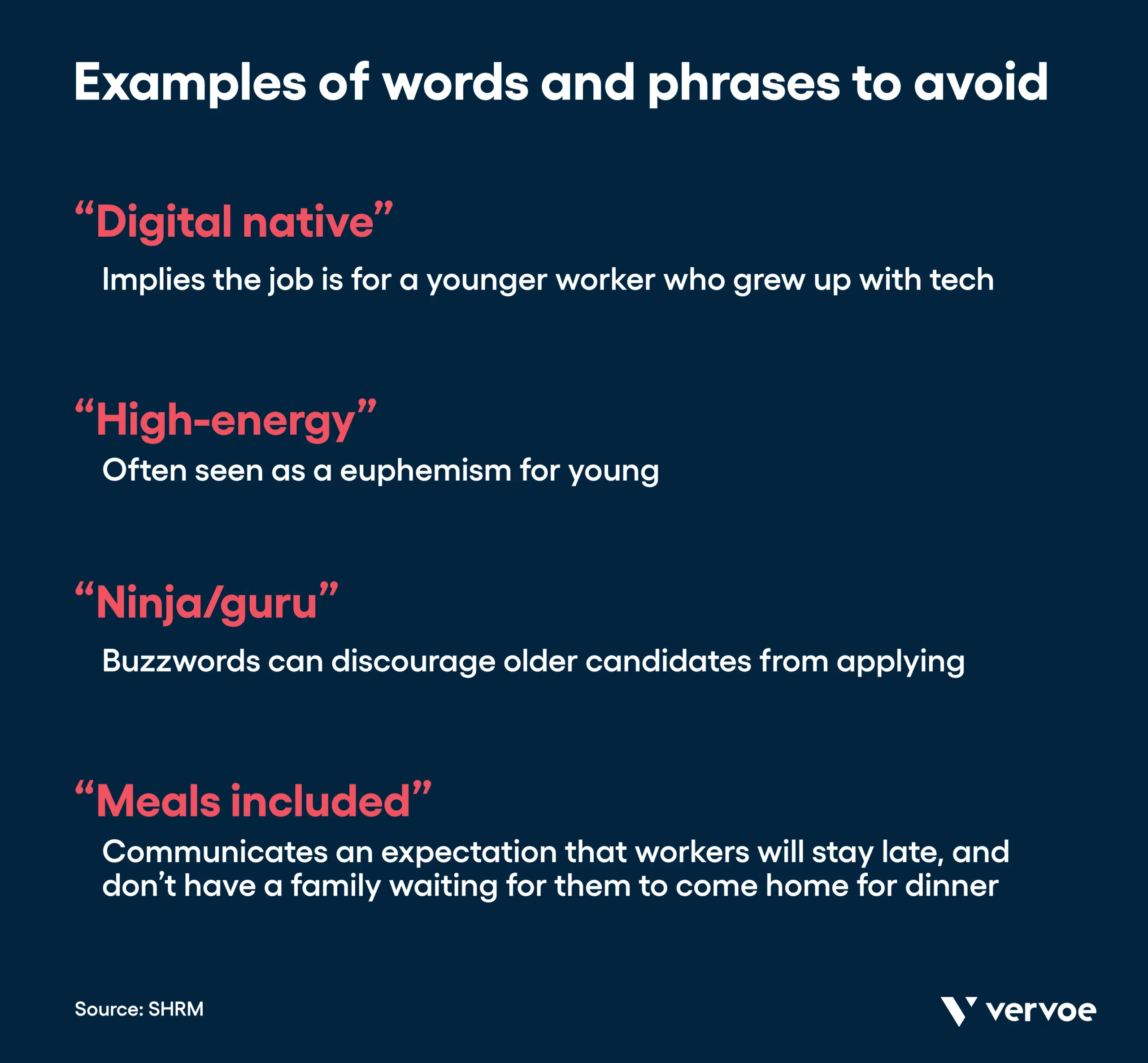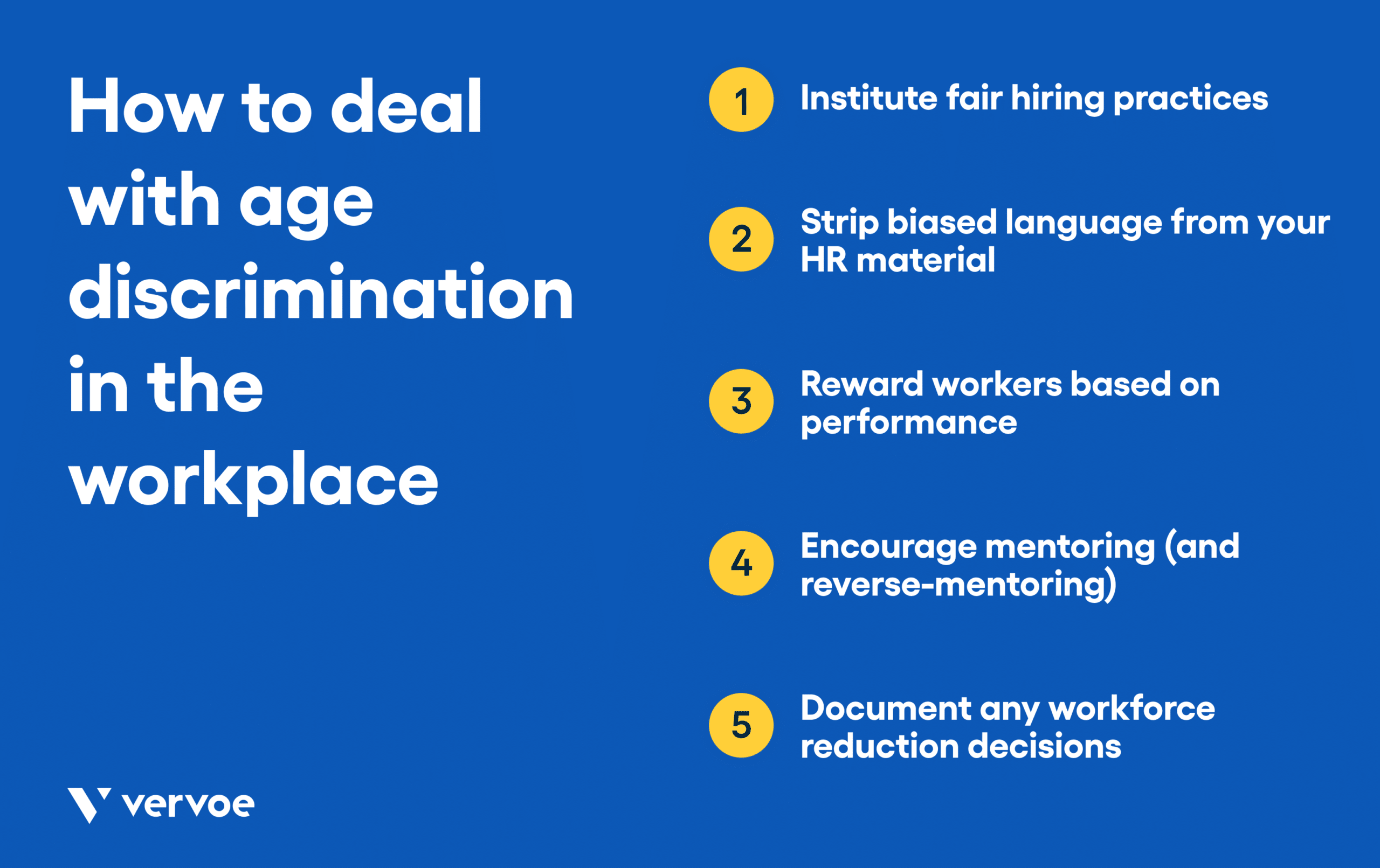Despite laws at the state and national levels prohibiting age discrimination, this form of bias persists at companies of all sizes. Analysis shows that more than half of older workers in the US are pushed out of the workforce before they choose to retire, causing personal financial damage that is often irreversible.
It’s not just older workers who struggle with preventing age discrimination in the workplace. Reverse age discrimination against younger generations is equally pervasive, and these stereotypes aren’t prohibited by federal law.
Companies that struggle to work out how to address age discrimination in the workplace may eventually face litigation; more likely, these organizations will struggle to create a diverse, inclusive workforce that can help the business grow sustainably. Here’s how to recognize age discrimination that may be happening in your workplace, and what to do about it.
What is age discrimination in the workplace?
Age discrimination in the workplace happens when an applicant or employee is treated differently because of his or her age. Age discrimination can take place in many aspects of employment, from hiring and firing to compensation, job assignments, promotions, and any other condition of employment.
The common perception of age discrimination is bias against older workers, like saying Baby Boomers don’t know how to use technology, for instance. These stereotypes are pervasive, but age discrimination extends to younger generations, too. A 2019 survey from Glassdoor found that younger employees (ages 18-34) were more likely to experience ageism at work than older employees (55+).
There are some regulations in place to combat discrimination against age in the workplace; however, recruitment and HR teams need to do more to combat ageism and realize the benefits of age diversity in the workplace.
[Read more: 5 Benefits Of Age Diversity In The Workplace]
Laws around age discrimination in the workplace
There are federal protections in place to combat age discrimination in the workplace. Critics say that while these protections help, they don’t go far enough to completely stifle age discrimination.
So, should age discrimination be made illegal in the workplace?
Well, the Age Discrimination in Employment Act (ADEA) does make it illegal to discriminate against people age 40 and older. This law was passed in 1967 and is enforced by the Equal Employment Opportunity Commission (EEOC). Specifically, the ADEA prohibits discrimination on the basis of age in hiring, promotion, compensation, layoffs, or in the terms and benefits of employment. It was followed by the Older Workers Benefit Protection Act of 1990 (OWBPA), which amended the ADEA to prohibit employers from denying benefits to older workers, specifically.
The ADEA was weakened in 2009 following a Supreme Court decision, Gross v. FBL Financial Services, Inc. This ruling imposed a higher burden of proof on employees claiming age discrimination, as compared to those who claim discrimination on the basis of race, religion, or gender. Successful age discrimination cases have dropped in the years following this Supreme Court decision, which essentially requires age discrimination to be “blatant”.
And, unfortunately, the ADEA only applies to older workers. “Reverse” age discrimination in the workplace — e.g., bias against younger employees — isn’t covered by the ADEA. It is not illegal for an employer or other covered entity to favor an older worker over a younger one, even if both workers are age 40 or older. Some states, such as Connecticut, Iowa, and Maine also have laws to protect younger workers from age discrimination.
Why age discrimination still exists
Age discrimination, like many other forms of discrimination, often stems from unconscious bias. Not only is ageism often unconscious, but it’s also considered an “acceptable” form of bias, according to the AARP. That is, it has become acceptable to discriminate based on age because it’s so pervasive — few people recognize that this practice is actually illegal.
Another expert suggests that age discrimination still exists because companies view their workers as “human capital” — “You buy it, you assume it has a certain shelf life, and then you get rid of it and replace it with a new model,” Paul Rupert, founder, and CEO of Respectful Exits, told AARP.
Age discrimination is also rooted in biases about generational differences. Boomers are often perceived as out of touch and unable to adopt new technology, while Generation X are “square”. In reality, however, these generational stereotypes don’t hold up. When researchers analyzed 20 different studies with almost 20,000 people of different generations, they found that while individuals may change what they need and are interested in over the course of their career, group differences based on age or generation aren’t supported.
There are myriad reasons for age discrimination in the workplace, which can make it difficult to target and mitigate.
How to spot age discrimination in 2021
Subtle age discrimination in the workplace exists in many forms. Blatant ageism — a hiring manager saying a candidate is “too old” for the job — is rare. But, the language used in job descriptions, recruiting methods, and other employment practices can enforce hidden age bias in hiring. Here are a few more insidious examples of age discrimination in the workplace:
- A job description seeking “digital natives”
- A job posting that requires an “.edu” or college-affiliated email address to apply
- Limiting recruitment for entry-level positions on college campuses
- Capping the number of years of work experience that someone can have (e.g., no more than five years of experience).
Most of these examples apply to age discrimination against older workers, but reverse ageism is just as prevalent — if not more so. Millennials and Gen Z workers are often stereotyped as entitled, lazy, or inexperienced.
“According to my research, this is what reverse ageism can look like: More senior or experienced employees overlooking feedback from younger colleagues on projects. Seasoned employees assuming that younger colleagues can’t be trusted with important tasks. Or younger colleagues being the target of stereotypical age assumptions,” wrote one researcher in the Harvard Business Review.
All types of age discrimination in the workplace can hurt both employees and companies. Data shows that age diversity, like other forms of diversity, helps companies be more innovative, productive, and, ultimately, profitable.
[Read more: The Ultimate Guide To Diversity Hiring In 2021]
How to deal with age discrimination in the workplace
Eliminating age discrimination both protects your business from potential litigation and increases diversity, which brings a whole range of benefits. What steps can you take to avoid age discrimination in the workplace?
Institute fair hiring practices
Tackling age discrimination starts with the very first opportunity someone has to interact with your company: the hiring process. Fair hiring offers a solution to the multi-faceted problem of discrimination — not limited to age discrimination. By prioritizing these six fair hiring practices, you can begin to build a workforce that is inclusive of all ages, perspectives, and experiences.
[Read more: How To Cut Unfair Hiring Practices From Your Hiring]
Strip biased language from your HR material
As we outlined above, language can often be a subtle form of age discrimination. Provide training to your HR team to recognize how what you say, or write, may discourage employees of different ages from thriving at your organization. Here are some examples of words and phrases to avoid:
- “Digital native” – implies the job is for a younger worker who grew up with tech
- “High-energy” – often seen as a euphemism for young
- “Ninja” or “guru” – buzzwords can discourage older candidates from applying
- “Meals included” – communicates an expectation that workers will stay late, and don’t have a family waiting for them to come home for dinner.
Even asking employees to provide a GPA can imply that the organization is looking for a worker in a specific life phase, where that record would still be relevant. It’s preferable to even the playing field with a skills assessment, which is not only more relevant but fairer.

Reward workers based on performance
Promotion policies and other incentives must follow clear, equitable guidelines. Employees will leave if they feel unrecognized for their hard work or if there is no clear path for career progression.
Unfortunately, many companies set up their rewards structure based on tenure. Instead, set up your promotion policy and pay rises based on the individual’s value and contributions to the company. Offer equitable training and development opportunities for all employees, regardless of their age or experience. Your HR team should develop a structured appraisal process that correlates value with performance. Promotion decisions should take into account 360-degree feedback, performance metrics, and individual goals.
Encourage mentoring (and reverse-mentoring)
Mentoring is one way to bring employees of all ages together. It can help foster a more inclusive work environment as well as break down some of the stereotypes surrounding generational differences and ageism. Pair older and younger workers together to reap the benefits of mentoring — and reverse mentoring. Younger employees aren’t the only ones who need guidance: workers of any age can pass along skills.
Document any workforce reduction decisions
Layoffs are often where age discrimination rears its ugly head. Any workforce reductions should be well-documented to avoid a potential lawsuit. This includes creating objective criteria against which to make layoff decisions. Criteria may not disproportionately impact workers of a certain age: it may be helpful to conduct an analysis to make sure your workforce reduction doesn’t inadvertently target a specific generation. Even criteria that may seem aboveboard — for example, laying off employees who don’t have a certain degree or certification — can be discrimination, if that degree wasn’t available when older workers graduated college.
Final thoughts
Despite the fact that age discrimination is illegal, it still exists in many forms in today’s workplace. That’s partly because stereotypes about age and generational differences are so pervasive and widely accepted. However, age discrimination prevents organizations from fostering an inclusive, diverse workforce — which, as we know, is key to sustainable, long-term success. To combat age discrimination, HR teams must commit to fair hiring, develop policies that protect workers from unfair layoffs or career obstacles, and provide ways for employees of all ages to collaborate.






















